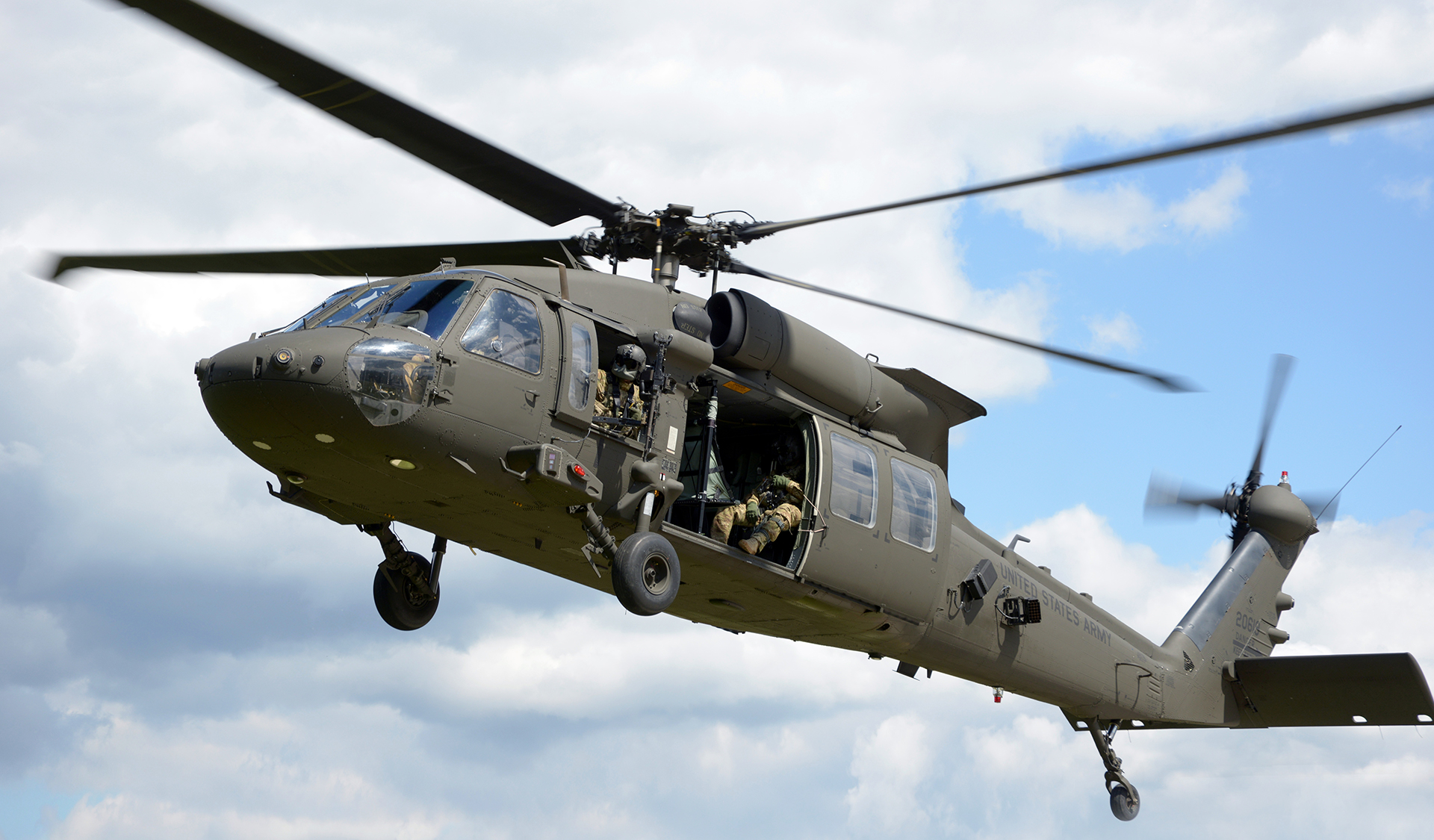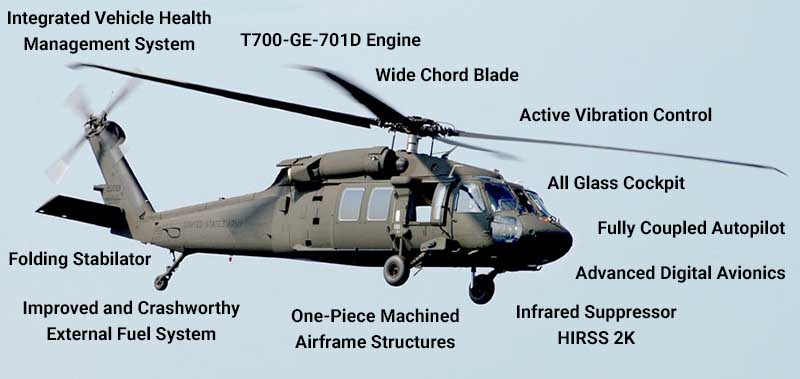Just how the UH 60 Continues to Evolve for New Armed Force and Civilian Applications
Just how the UH 60 Continues to Evolve for New Armed Force and Civilian Applications
Blog Article
UH-60: Innovations in Modern Helicopter Design
The UH-60 helicopter stands as a benchmark in contemporary aviation, showcasing considerable innovations in design and innovation that provide to the developing demands of army procedures. As we explore the development and vital developments of the UH-60, it ends up being essential to consider just how these growths influence not only present applications yet also the future landscape of helicopter design.

Development of the UH-60
The evolution of the UH-60 Black Hawk helicopter represents a substantial turning point in aerospace engineering and military aeronautics. Introduced in the late 1970s, the UH-60 was designed by Sikorsky Airplane to satisfy the United States Military's need for a flexible utility helicopter efficient in carrying out a variety of missions. Its design emphasized rate, maneuverability, and toughness, establishing brand-new requirements for functional performance.
The UH-60 includes a distinctive four-blade blades system, which enhances lift and security, permitting it to operate properly in diverse settings. Its airframe is constructed from sophisticated composite products, contributing to a reduction in weight while keeping structural stability. The helicopter's layout also integrates improved aerodynamics, which improves gas efficiency and boosts range.
Throughout the years, the Black Hawk has actually undergone several upgrades to boost its capabilities, including enhanced engines, progressed trip control systems, and modular systems for easy maintenance and versatility. The helicopter's capacity to perform objectives ranging from troop transportation to clinical discharge has solidified its role as a foundation of united state army procedures. The UH-60 Black Hawk continues to be a prime example of exactly how advancement in helicopter layout can significantly affect armed forces performance and operational flexibility.
Advanced Avionics Systems
Developments in avionics systems have changed the abilities of contemporary helicopters like the UH-60 Black Hawk, improving functional efficiency and situational understanding (UH 60). The integration of sophisticated avionics permits boosted navigation, communication, and flight monitoring, making the UH-60 a lot more functional in varied objective profiles
One of the key features is the advanced electronic cabin, which utilizes multifunction displays that provide real-time data, ensuring pilots have immediate access to critical trip info. This streamlining of information minimizes pilot work and improves decision-making procedures during complex procedures. In addition, the consolidation of GPS and inertial navigating systems makes it possible for accurate positioning and route preparation, enhancing mission implementation in tough settings.
Furthermore, advanced avionics systems boost communication capabilities via safe data web links and voice communication systems, allowing smooth coordination with ground pressures and other airplane. The combination of automated flight control systems further adds to enhanced security and control, particularly in damaging weather or during low-altitude maneuvers.
Engine and Efficiency Enhancements
Engine performance in modern-day helicopters has taken a substantial leap ahead, driven by innovations that improve reliability, power, and effectiveness. At the forefront of these improvements is the adoption of more effective turboshaft engines, specifically those employing sophisticated products and technologies that allow greater temperature level resistances and enhanced drive capacities. The UH-60 Black Hawk, as an example, utilizes the T700-GE-701C engine, which features a dual-channel, full-authority electronic engine control system. This system boosts efficiency while optimizing fuel consumption and lowering upkeep needs.
In addition, the integration of engine health monitoring systems permits real-time diagnostics and anticipating upkeep, significantly boosting functional integrity. These systems not just sharp teams to prospective problems before they become crucial but also facilitate extra reliable upkeep organizing, consequently minimizing downtime.

Products and Structural Innovations
Current developments in materials and architectural layout have actually changed modern-day helicopter construction, improving both performance and toughness. The intro of innovative composite products, such as carbon fiber enhanced polymers, has considerably minimized weight while preserving structural stability. This shift not only improves fuel efficiency but also increases payload capacity, allowing helicopters like the UH-60 to perform more varied goals.
In addition, advancements in aluminum alloys and titanium components have actually added to boosted resistance to deterioration and tiredness, extending the life-span of essential airframe aspects. The tactical use these products has brought about a decrease in maintenance requirements and boosted general functional preparedness.

Furthermore, the assimilation of computer-aided design (CAD) and additive production technologies has actually enabled extra complex geometries and light-weight frameworks, enhancing the aerodynamic performance of helicopter designs. These developments promote quick prototyping and production, allowing producers to react quickly to evolving objective demands.
Safety and Survivability Functions
Safety and survivability features in contemporary helicopter layout have actually ended up being paramount, reflecting the increasing demands for goal effectiveness in challenging atmospheres. The UH-60 Black Hawk, a notable example, integrates advanced innovations to boost crew and passenger security. Among one of the most critical developments is the consolidation of crashworthy gas systems made to minimize the risk of fire during impact. Furthermore, the airframe is built with enhanced products that absorb and dissipate energy, further safeguarding residents in case of an accident.
The helicopter additionally uses a ballistic security system, that includes armored team seats and important systems shielding, reducing susceptability to little arms fire and shrapnel. Enhanced situational awareness is attained via sophisticated avionics and sensor technologies, permitting pilots to find and prevent risks effectively.
In addition, the assimilation of redundancy in essential systems-- such as double engines and multiple trip control networks-- guarantees ongoing operation even if one system falls short. The UH-60 is geared up with advanced emergency situation flotation tools, boosting survivability in water landings. Jointly, these functions not only enhance the safety of employees however additionally enhance mission success prices in aggressive atmospheres, showing the dedication to excellence in click here for more helicopter layout.
Conclusion
The UH-60 helicopter stands for a considerable advancement in contemporary aeronautics innovation, including innovative products, cutting-edge avionics, and durable safety and security functions. Its evolution shows a commitment to improving efficiency and operational effectiveness while making certain pilot and crew survivability. The assimilation of light-weight composites Website and advanced navigating systems emphasizes the helicopter's adaptability in different army missions. Generally, the UH-60 offers as a benchmark for future advancements in helicopter style, personifying resilience and flexibility in modern army operations.
The UH-60 helicopter stands as a benchmark in modern aviation, showcasing significant developments in style and technology that cater to the evolving demands of army procedures. As we check out the development and essential developments of the UH-60, it ends up being vital to think about exactly how these developments influence not just existing applications yet additionally the future landscape of helicopter style.
Introduced in the late 1970s, the UH-60 was developed by Sikorsky Aircraft to fulfill the United States Military's requirement for a versatile energy helicopter qualified of doing a range of missions. The UH-60 Black Hawk remains a prime instance of just how advancement in helicopter design can significantly influence armed forces effectiveness and functional versatility.
In general, the UH-60 serves as a standard for future advancements in helicopter design, personifying durability and flexibility in contemporary military operations.
Report this page